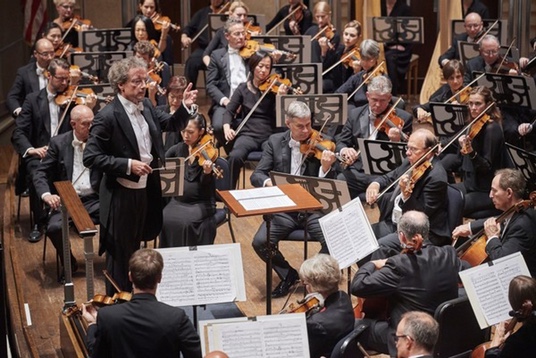
Thu 10/4-Sat 10/6
The Cleveland Orchestra, with Franz Welser-Möst conducting, offered a bliss-inducing performance of Gustav Mahler’s Symphony No. 2 in Severance Hall on Thu 10/4. This work is often dubbed the “Resurrection” Symphony, in part because Mahler (for all his denial that commentary should guide a listener) once described it as relating to death and our feelings about the meaning of life and our hopes for illumination.
The final movement made all that clear (if still mystical) when the chorus and soloists almost whisper-breathed the closing words, “I shall fly upward/to that light which no eye has yet seen! . . . . Rise again, yes, you will rise again. …Your own beating [heart] will take you to God!”
It’s an important topic: the meaning of life. Fittingly this symphony is also one with highly demanding instrumental requirements. To be specific (and from the program): four flutes (all four doubling piccolo), four oboes, three clarinets, two E-flat clarinets, four bassoons (one doubling contrabassoon), eight horns, six trumpets, four trombones, tuba, two sets of timpani, percussion (snare drums, bass drum, cymbals, two tam-tams, triangle, glockenspiel, three bells, rute [a bundle of twigs or a birch-broom]), two harps, organ, and strings, plus soprano and alto soloists, and mixed chorus. In the final movement, there is an offstage band of two horns, four trumpets, timpani, bass drum, cymbals, and triangle. Plenty of sound for everyone and sound made by the excellent musicians of TCO is dependably the best.
Soprano Joélle Harvey and mezzo-soprano Sasha Cooke brought vibrant life to passages, some solo, some accompanied by the choir in the final movements.
Made up of well over one hundred singers, the fabulous chorus, directed by Lisa Wong, seemed to represent all of humanity. They came onstage after the first movement and then most patiently sat and waited until almost the end of the program. It was worth the wait (at least for me) when they began to sing. The ethereal effect of their voices — so typical of how we often react to life’s shifts and changes — murmurs, then shouts, clamouring, pleading, and then moving measured tranquility suggested a sense of illumination (no matter how brief).
BOTTOM LINE: So it’s big and long, but it’s worth taking 80 minutes to quietly contemplate Mahler’s vision. He was a man who seems to have felt much and cared deeply. Given its scope and demands, it’s a rarely programmed Mahler work (it was last here in 2007). Go if you can. (Or take a listen on YouTube to this transcendent work.)